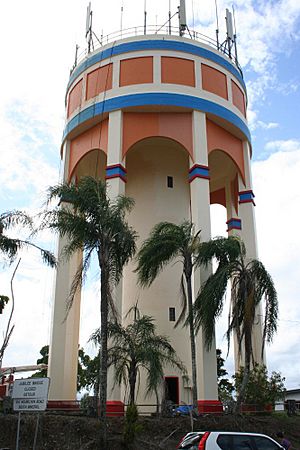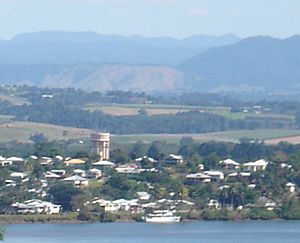Innisfail Water Tower facts for kids
Quick facts for kids Innisfail Water Tower |
|
|---|---|

Innisfail Water Tower, 2010
|
|
| Location | Mourilyan Street, East Innisfail, Cassowary Coast Region, Queensland, Australia |
| Built | 1933-1934 |
| Architectural style(s) | Art Deco |
| Official name: Innisfail Water Tower | |
| Type | state heritage (built) |
| Designated | 6 August 2010 |
| Reference no. | 602757 |
| Significant period | Interwar Period |
| Builders | Van Leeuwen Brothers |
| Lua error in Module:Location_map at line 420: attempt to index field 'wikibase' (a nil value). | |
The Innisfail Water Tower is an important old water tower located on Mourilyan Street in East Innisfail, Australia. It was built between 1933 and 1934 by the Van Leeuwen Brothers. This tower is a special landmark and is listed on the Queensland Heritage Register because of its historical importance.
A Look Back: The Tower's Story
The Innisfail Water Tower was built in 1933 and 1934. It was a big part of a major project to improve the town's water supply. The tower stands on Mellick's Hill in East Innisfail. From there, you can see it from all over the town of Innisfail, making it a key landmark.
Innisfail's Early Days
In the early 1930s, Innisfail was the main town in the Johnstone Shire. It was a very important center for Queensland's sugar-growing areas. Thomas Henry Fitzgerald helped start the town. He chose the area in 1880 because it was great for growing sugar. Other sugar companies soon joined in, and by 1884, three sugar mills were working. The town was first called Geraldton in 1883, but its name changed to Innisfail in 1910.
By the early 1900s, Innisfail was growing fast. New buildings, often made of timber and iron, replaced older ones. Many businesses opened, like a bakery and hotels. The riverfront had wharves, and there were sawmills. A ferry helped people cross the South Johnstone River, which was the main way to get in and out of town.
Rebuilding After Disasters
The sugar industry helped Innisfail grow, but the town also faced big challenges. Major floods and cyclones often hit the area. The 1918 Innisfail cyclone was very strong. It destroyed most of the buildings in town. Because of this, much of the rebuilding in the 1920s and 1930s used strong reinforced concrete. This was done to protect buildings from future cyclones.
Why Innisfail Needed a Water Tower
People in Innisfail used to rely on rainwater tanks and water sellers. Even though Innisfail gets a lot of rain, there were often water shortages in the dry months. So, in 1926, plans began for a town water supply system.
In 1930, the government's Irrigation and Water Supply Sub-Department looked at different ideas. They designed a system using water from Fisher's Creek. However, the local council didn't get funding until 1932. Councillor Clarence Stanley Kopsen Page strongly supported the idea. He said a new water system would help start a fire brigade and improve public health. It would also provide water for homes and public gardens. The local newspaper even reported that dusty roads were causing "miniature desert storms" during a dry spell.
Getting the Water Project Started
The council's new request for funding was approved. The Queensland Treasurer gave them a grant of £15,500 and a loan of £30,750. This led to some debate about the best way to get water. Some people thought it would be cheaper to use natural springs instead of pumping from the North Johnstone River. They also questioned if a filtration plant was needed.
The Irrigation and Water Supply Sub-Department explained why their plan was best. They said the estimated costs were fair compared to other towns. They also confirmed that the Johnstone River would be the most reliable water source.
Helping People Find Jobs
The Innisfail Water Supply Scheme was part of a special program by the Queensland Government. This program aimed to help people find jobs during tough economic times. The government provided money for town water supply projects. For the Innisfail project, local workers and materials had to be used. Materials also had to be transported by train.
This program was very successful. By January 1934, it had provided jobs for 525 men across Queensland. It also helped companies that supplied materials for these projects.
How the Water System Worked
The new Innisfail water system was bigger than earlier plans. It included a filtration plant, which was important for preventing bacterial disease. The system had several parts:
- A low-level pumping plant with two electric pumps at Stoter's farm on the Johnstone River.
- A filtration plant with two pumps, located half a mile from the pumping plant.
- A large 100,000-imperial-gallon (450,000 L; 120,000 US gal) water tower on Mellick's Hill in East Innisfail.
- A network of pipes to deliver water throughout the town.
The Shire's power station supplied electricity to both the pumping and filtration plants.
Building the Tower
By February 1933, work began on the pumping station and laying pipes. The construction of the water tower was a separate big job. Eight companies submitted bids to build the 100,000-imperial-gallon (450,000 L; 120,000 US gal) reinforced concrete water tower. In June 1933, the Van Leeuwen Bros won the contract. They had come to Innisfail from the Netherlands in 1918. They became one of the most successful construction companies in town. They built many important buildings, including banks, hotels, and the Shire Hall, as well as the water tower.
Over the next year, the local newspaper often reported on the tower's progress. By December 1933, 19 men were working on it. They poured concrete for the columns and the central tower. In January, the columns reached 29.5 feet (9.0 m) high. The pipes and valve pit inside the tower were also put in place.
Despite heavy rain, the final concrete pour for the tank's base was done in April. This pour used 200 long tons (200 t) of concrete and took 19 hours! On May 18, 1934, 21 local men worked for 27 hours to concrete the tank wall. This wall was 13 feet (4.0 m) high and 134 feet (41 m) around. By June 6, the tank's dome was finished in one continuous pour. At 42 feet (13 m) wide, it was one of the largest reinforced concrete domes in Queensland.
During construction, people talked about making the tower even more special. Ideas included advertising or a town clock. But the Shire Council decided to add a lookout instead. A guard rail for the lookout was put up after the dome was finished. The tower was painted, but lighting it up was too expensive.
Even though the filtration plant was still being built, the first property was connected to the water system on August 27, 1934. This was Oroya Private Hospital. Having a water supply also meant the Volunteer Fire Brigade could start their work.
The filtration plant was finished in 1935. On December 16, the entire water supply system was officially given to the Johnstone Shire Council. By then, 548 properties were connected, providing water to 2500 people.
A government report from 1933-1934 said the Innisfail Water Tower was a "dignified structure of imposing appearance overlooking the town." It also noted that great care was taken to make the concrete structures look good.
Water Towers of the 1930s
The government's Water Supply Branch was very busy in the 1930s. They funded many projects, including 22 town water supply schemes. During this time, 15 of these schemes included a tall reinforced concrete water tower. Most tanks held 60,000 or 100,000 to 120,000 imperial gallons (270,000 or 450,000 to 550,000 L; 72,000 or 120,000 to 144,000 US gal) of water. Innisfail's tower was one of the first 100,000-imperial-gallon (450,000 L; 120,000 US gal) tanks.
Larger towers, like Innisfail's, often used both a central tower and surrounding columns for support. For example, the tower at Emerald had a central tower. The Gordonvale tower had a cylindrical tank on columns. Towers in Gatton, Innisfail, Longreach, and Ingham used both a central tower and columns. The Innisfail tower also has decorative panels and special tops on its columns, called capitals.
What the Tower Looks Like Today
The Innisfail Water Tower sits on top of a hill on Mourilyan Road, east of the Johnstone River. It stands out against the sky and shows off the Art Deco style seen in many other buildings in Innisfail.
The tower is made of reinforced concrete. It has a round tank supported by a central cylinder and eight rectangular columns. It is surrounded by palm trees and a low stone fence with an iron railing.
The tank wall has a continuous molding and recessed panels. Below the tank, curved concrete supports connect the columns. The columns have decorative moldings at the top, like capitals, and bases called plinths. The tower is currently painted in pale yellow with details in teal blue, terracotta orange, and red.
The Innisfail Water Tower originally had a lookout, and it still offers great views of the area. Inside the central tower, concrete stairs with a metal handrail lead up to the tank. Three windows let natural light into the stair landings. The concrete inside is unpainted.
Around the top edge of the tank, there's a metal balustrade. This balustrade now holds aerials for local phone companies. A metal frame covers a central opening where a ladder leads up to the dome. The concrete on the dome is mostly unpainted.
Why the Tower is Important
The Innisfail Water Tower was added to the Queensland Heritage Register on August 6, 2010. It is important for several reasons:
It shows how Queensland's history has changed. Built in 1933-1934, the tower shows the early development of Innisfail's water supply. It also represents a time when the sugar industry in North Queensland was growing and successful. The tower is also a great example of the Queensland government's programs to provide jobs during the 1930s. Many public projects, like water systems, town halls, and roads, were built during this time to help people find work.
It is a great example of its kind. The Innisfail Water Tower is a well-preserved example of a 1930s reinforced concrete water tower. It was one of 15 built in Queensland during that period. It was designed by the Irrigation and Water Supply Sub-Department. It uses both a central tower and surrounding support columns, which was common for larger towers from the mid-1930s. It was also one of the first towers to use both these features. At the time it was built, its dome top was one of the largest in Queensland.
It has great aesthetic significance. The Innisfail Water Tower is a unique landmark that you can see from all over Innisfail. When it was built, people described it as a "dignified structure of imposing presence." Through the job relief programs, a lot of effort was put into making concrete structures look good. The Innisfail Water Tower clearly shows these design ideas, which focused on simple, functional beauty, typical of the Art Deco style popular in the 1920s and 1930s.


